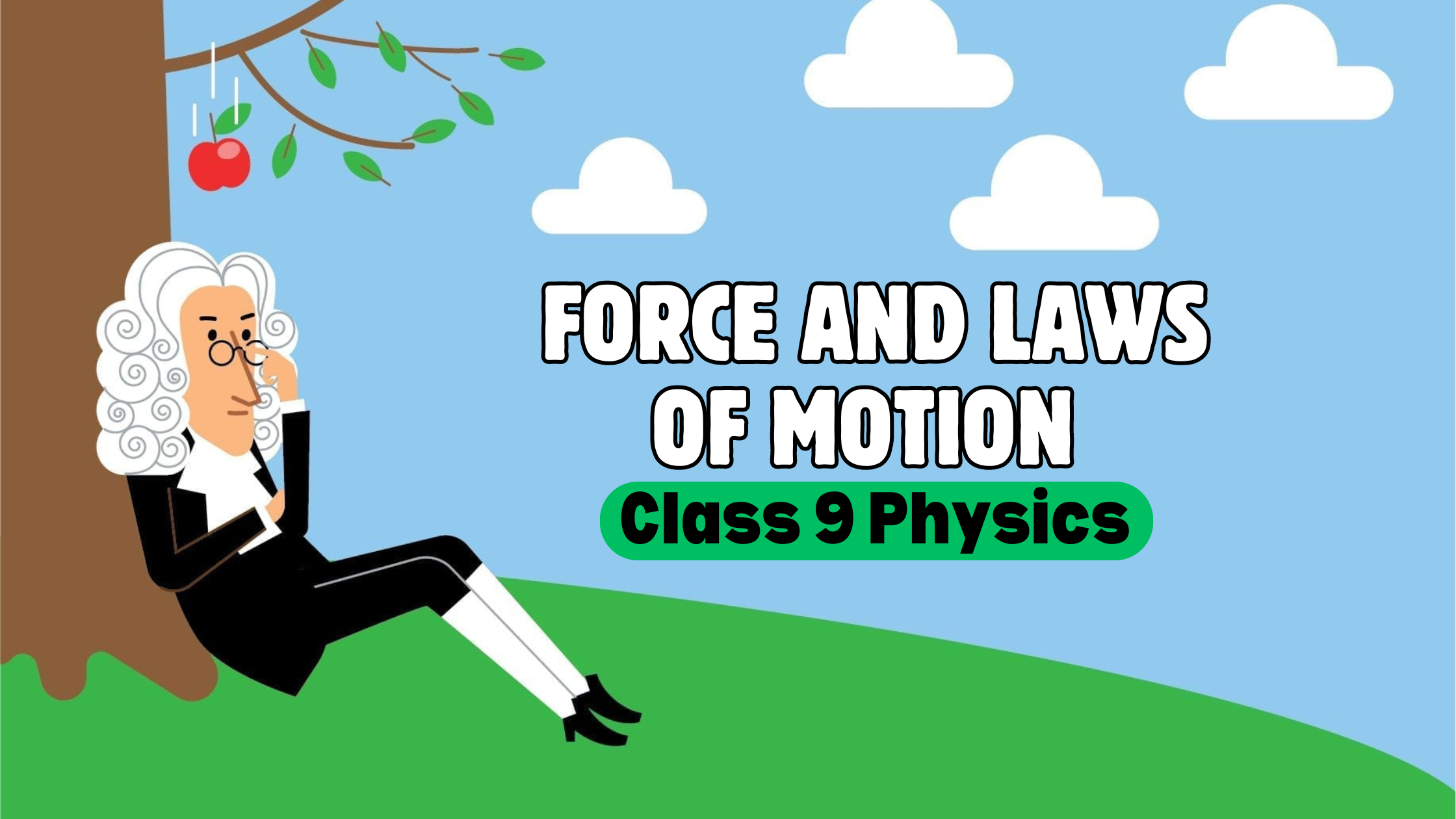We are providing you with the short and detailed notes of Force And Laws Of Motion class 9 along with the Ncert solutions and important graphs and diagrams. Students after going through this article would get help to solve the numerical and would be able to know how to attempt important questions.
Introduction
Force: It is a push or pull on an object that produces an acceleration in the body on which it acts. S.I. the unit of force is Newton.
A force can do three things on a body.
- It can change the speed of the body.
- It can change the direction of motion of a body.
- It can change the shape of a body.
Balanced forces: Forces are said to be balanced forces if they nullify one another and their resultant force is zero.
Frictional force: The force that always opposes the motion of objects is called a force of friction.
The second law of motion: The rate of change of momentum of an object is proportional to the applied unbalanced force in the direction of the force. Mathematically,
Momentum: The momentum of an object is the product of its mass and velocity and has the same direction as that of the velocity. Its S.I. unit is kg m/s.
Newton- A force of one Newton produces an acceleration of 1 m/s2 on an object of mass 1 kg.
- = 1 kg m/s2 (F = ma)
Third law of motion- To every action, there is an equal and opposite reaction and they act on two different bodies.
Conservation of momentum- If the external force on a system is zero, the momentum of the system remains constant i.e., in an isolated system, the total momentum remains conserved.
Suppose A and B are two balls, they have mass mA and initial velocities up to and up as shown in the above figure before the collision. The two bodies collide and force is exerted by each body. There is a change in their velocities due to collision.
Unbalanced forces- When two opposite forces act on a body, move a body in the direction of the greater force or forces which bring a motion in a body are called unbalanced forces.
The first law of motion- An object remains in a state of rest or of uniform motion in a straight line unless acted upon by an external unbalanced force.
Inertia: The natural tendency of an object to resist a change in its state of rest or of uniform motion is called inertia.
The mass of an object is a measure of its inertia.
Its S.I. unit is kg.
A body with greater mass has greater inertia.
(more + more) is the total momentum of the two balls A and B before the collision and (move + move) is their total momentum after the collision.
The sum of momenta of the two objects before the collision is equal to the sum of momentum after the collision, provided there is no external unbalanced force acting on them.
This is known as the law of conservation of momentum.
NCERT Solutions For Class 9th Force And Laws Of Motion
Q1. Which of the following has more inertia:
(a) a rubber ball and a stone of the same size?
(b) a bicycle and a train?
(c) a five-rupees coin and a one-rupee coin?
Answer:
(a) A stone of the same size
(b) a train
(c) a five-rupees coin
The mass of the object is a measure of its inertia, more the mass of an object more will be its inertia.
Q2. In the following example, try to identify the number of times the velocity of the ball changes.
“A football player kicks a football to another player of his team who kicks the football towards the goal The goalkeeper of the opposite team collects the football and kicks it towards a player of his own team”.
Also, identify the agent supplying the force in each case.
Answer:
The velocity of football changes four times. First, when a football player kicks another player, second when that player kicks the football to the goalkeeper. Third when the goalkeeper stops the football. Fourth when the goalkeeper kicks the football towards a player of his own team.
Agent supplying the force
- First case First player
- Second case Second player
- Third case Goalkeeper
- Fourth case Goalkeeper
Q3. Explain why some of the leaves may get detached from a tree if we vigorously shake its branch.
Due to the inertia of rest, the leaves tend to remain in their position and hence detach from the tree to fall.
Q4. Why do you fall in the forward direction when a moving bus breaks to a stop and fall back when it accelerates from rest?
When a moving bus breaks to a stop- With the movement of the bus our body is also in motion, the lower part of the body comes at rest. The upper part continues to be in motion due to inertia.
When the bus accelerates from rest we fall backward- When the bus’ is stationary our body is at rest but when the bus accelerates, the lower part of our body is in contact with the floor of the bus comes into motion, but the upper part of our body remains at rest due to inertia of rest. Hence we fall in the backward direction.
Q5. If action is always equal to the reaction, explain how a horse can put a cart?
The third law of motion states that action is always equal to the reaction but they act on two different bodies. The ground exerts an equal and opposite force on the feet of the horse, which enables the horse to move forward and the cart is pulled by the horse.
Q6. Explain why it is difficult for a fireman to hold a hose, which ejects a large amount of water at a high velocity.
The water that is ejected out from the hose in the forward direction comes out with a large momentum and an equal amount of momentum is developed in the hose in the opposite direction hence the hose is pushed backward. It becomes difficult for a fireman to hold a hose that experiences this large momentum.
Q 7. From a rifle of mass 4 kg, a bullet of mass 50 g is fired with an initial velocity of 35 m/s. Calculate the initial recoil velocity of the rifle.
Answer:
The rifle and the bullet make a system. Since there is no external force acting on it the momentum of the system should be conserved.
Note:- Negative sign indicates that recoil velocity is opposite to the motion of the bullet.
Question 4. Two objects of masses 100 g and 200 g are moving along the same line and direction with velocities of 2 m/s and 1 m/s respectively.
They collide and after the collision, the first object moves at a velocity of 1.67 m./s. Determine the velocity of the second object.
Answer:
Before Collision After collision
A B A B
100 g 200g 100g 200g
2m/s 1m/s
Let the 100 g and 200 g objects be A and B as shown in the above figure.
The initial momentum of A
The initial momentum of B
The total momentum of A and B before a collision
Let the velocity of A after collision
The momentum of A after collision
Also, the momentum of B after the collision
The total momentum of A and B after the collision
Using the law of conservation of momentum, momentum of A and B after collision momentum of A and B before the collision
Conclusion
We have provided you with short and detailed notes of Force and laws of motion class 9 along with the Ncert solutions to help the students to clear their concepts and get the gist of the chapter.
Related Articles

